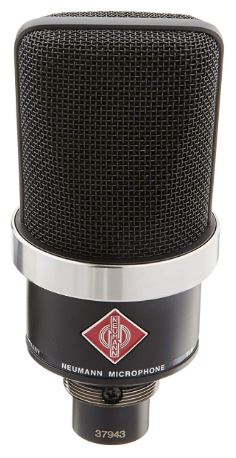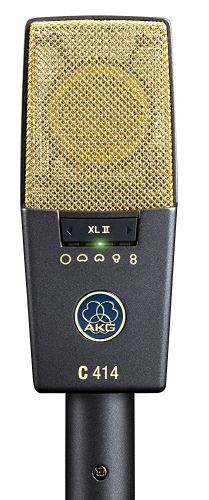In this post, we are reviewing the three amazing home studio recording microphones such as Neumann TLM 102, Neumann TLM 103, and AKG C414.
Last update on 2025-04-17 / Affiliate links / Images from Amazon Product Advertising API
We know that it is difficult to find the winner in this Neumann and AKG battle.
Don't worry. We are with you and help you to make a wide decision.
Let us have a look at the specifications first:
| Parameters | Neumann TLM-102 | Neumann TLM-103 | AKG C414 |
| Frequency response | 20Hz – 20kHz | 20Hz – 20kHz | 20Hz – 20kHz |
| Polar pattern | Cardioid pattern | Cardioid pattern | Omnidirectional, Figure 8, Wide cardioid, Cardioid, Hypercardioid |
| Sound pressure level | 144dB | 138dB | 140dB to 158dB |
| Rated impedance | 50 Ohms | 50 Ohms | 200 Ohms |
| Amazon product page | Check price | Check price | Check price |
Neumann TLM-102
How often do you find a Neumann product that's not very expensive?
Not very often, right?
The TLM-102 is one of such microphones. Make no mistake; it's not cheap, but when compared to other Neumann gear, it's one of the less pricey ones.
The first thing you'll probably notice with the TLM-102 is the small size—you know what they say about great things and small packages…
Neumann TLM-103
Neumann is a microphone powerhouse; it's no ordinary feat to exist as a company before and after the World War, and eventually become the first manufacturers of condenser microphones for commercial purposes.
They have carved such a niche for themselves that other microphone brands' products are rated using Neumann as a standard.
One thing that we must all remember is that the price of an equipment, regardless of how high or low it is, is never a full indication of quality. However, for the TLM-103, the quality more than justifies the tag.
AKG C414
The AKG C414 has a very eventful history. It is a legendary product of AKG that has been adjusted, upgraded and changed over time.
Through the many alterations, the manufacturers have managed to retain the original sound character that made the AKG C414 an audio professional's best friend.
Admit it.
The shape, design and other internal and external features have been adjusted over time, the latest update being the introduction of the LED inside the mic head.
We should find out why AKG has decided to stick with the C414 for so long in this article.
Neumann TLM 102 vs Neumann TLM 103 vs AKG C414
Build and design
With a weight of 210 grams, the TLM-102 is smaller than the TLM-103 and the AKG C414. The TLM-103 is the heaviest of the bunch with a weight of 450 grams.
The TLM-102 has a metallic grille that has more surface area than the rest of the mic. That's something you wouldn't find with most microphones. The grille and the lower part of the mic meet at a steel-bound joint.
The TLM-103 has a similar shape to the TLM-102, but here, the grille is closer to the rest of the mic in size.
The AKG C414 is quite different. It sports a shape that looks like a departure from what most modern mics look like. The microphone head has six sides, with half of it covered wit gold-plated mesh.
As far as colors go, there's not much varieties for the three mics.
What's more?
The AKG C414 comes in the nickel color only, while the TLM -103 and TLM-102 offer a variety of either nickel or black. The TLM-102 has the longest warranty of 2 years, compared to the 1-year warranty given for the C414 and TLM 103.
It's quite unexpected, because TLM-102 is not even the most expensive of all the mics.
Features
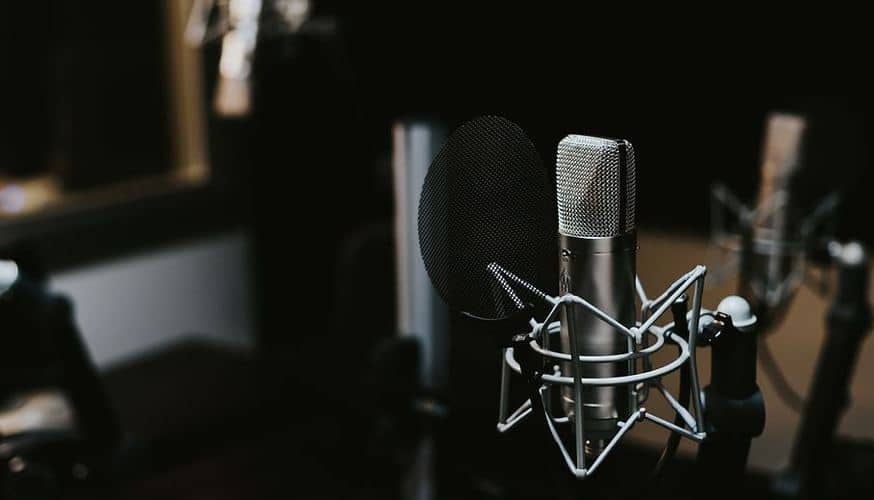
First, let's examine the sound pressure levels of these mics.
The TLM-102 has a sound pressure level of 144dB. What this means essentially is that it can record sound up to 144dB volume without distorting the sound.
This rating makes it very good for recording very loud instruments at close range. A good example is a loud brass ensemble. TLM-103 offers a slightly less SPL of 138dB.
Although a little less than TLM-102, it will definitely do a good job of high-level recording without distortion. For the AKG C414, the sound pressure level covers a range of 140dB to 158dB.
The reason for this is the pad switch that allows you to select a padding level of -6dB, -12dB or -18dB.
Obviously, the C414 gives room for more flexibility, but if you are not recording or capturing sound from extremely loud sources, I'll advise that you simply set the switch to the highest SPL.
All three microphones have a frequency range of 20Hz – 20kHz. However, there are subtle differences in their response at some particular frequencies.
We'll look into this while discussing about sound quality.
By the way, AKG C414 has the lowest self-noise among all the mics, with a self-noise level of 6dB-A.
For perspective, you should know that any noise level below 10dB is not audible by the human ear. The TLM-103 has a self-noise of 7dB-A.
The TLM-102 has the highest noise levels of them all, though it is still imperceptible to the human ears.
One feature that shows how diverse the identities of these microphones is their polar pattern.
The TLM-102 has a fixed cardioid pattern, while the TLM-103 has the cardioid pattern. The AKG C414, on the other hand, is equipped with FIVE different polar patterns that you can choose from.

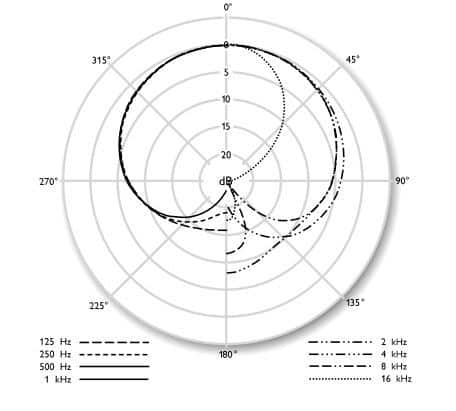
All it takes is just a switch and you're good to go. Now, I should take some time to explain what these patterns mean.The cardioid pattern of the TLM-102 and TLM-103 allows them to capture sound effectively from the front of the mic only.
If you record any vocal or instrument from any other position, all you will get is a shadow of what you should have.
Like I said earlier, the AKG C414 spoils us for choice; five polar patterns to cherry-pick from.
Yes, it's true. You heard it right!
How cool is that?
Here are the pattern options you have and how they can be of benefit to your work:
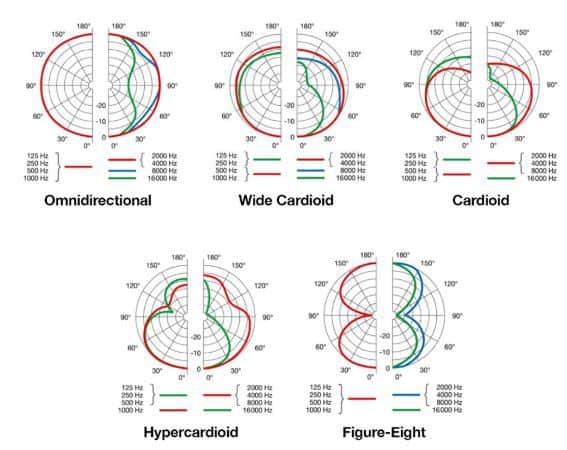
Credits: ciufo.org
Omnidirectional: This polar pattern allows you to record vocals from all sides of the microphone. If you record music, this setting can be very useful if you want to record background vocals from different singers at once.
Also, you can use this setting to record a percussion group in ethnic style music; just make them sit around the mic with their shakers and bells while you record at once.
Wide Cardioid: This polar pattern is a variation of cardioid, only with a slightly larger range. The microphone receives sound signal effectively from the front and the sides, with equal reach at the front and sides of the mic.
Cardioid: This is the popular pattern that allows effective sound input from the front of the mic. The sensitivity reduces as you move towards the sides.
Hypercardioid: This is essentially what you get when you combine the omnidirectional pattern with figure 8. It effectively captures sound from all angles except that little space directly behind the mic.
Figure 8: Sometimes called the bi-directional pattern, the strong spots of such microphones are the front and rear of the mics. This makes it a good choice for recording two artists facing each other at once. It can also be used to record a two-person conversation.
Sound quality

To be honest, I am tempted to go the traditional way and compare all these mics along the lines of bass, mids and treble response.
That would be the easy way out. However, the reality is that the TLM-102, TLM-103 and AKG C414 have individual characters, so comparing them with frequency charts may not tell the full story.

The TLM-102 easily sounds like vintage gear, with characteristic warm sound. Warm sound is popularly attributed to a little lift in the low mids along the frequency curve, but if this was the case, a singer whose voices have a lot of bodies should experience too much boost.
This is because their voice naturally seems to have a boost around the "warmth" enabling frequencies. For the TLM-103, it is not so.

In fact, it brings out the timbre in such performers' voices more beautifully. It basically adds a presence of the warmth without an audible low mid-frequency boost.
In terms of sensitivity and transparency, the TLM-103 can only be compared to the Neumann U87 and its ilk.
Please be advised, if your recording room is not well treated for reflections and diffusions, the TLM-103 is ever ready to expose it all.
This microphone practically records room reflections; that's how sensitive it can be. Also, it catches every single inflection and sound that the singer makes, no matter how inaudible they may seem. This is not bad news; it's very good news actually.
You can be sure that if you have a performer who loves to communicate emotion via different inflections, the TLM-103 has got your back through. If you record an acoustic guitar with the TLM-103, you hear the guitar inside and out—literally!
We can't really describe the AKG C414 with any particular characteristic. We might as well use a range of features, because there are so many options to consider. Taking into consideration all the switches on the AKG C414, there are 27 different voicing types you can have.
That being said, there's a particular sound quality that is consistent across these many voicing options. When you record lead vocals with the AKG C414, you hear the voice cut through even before mixing.
This is a real joy for every pop producer. The magic behind this identity lies around 1Khz of its frequency distribution. There is a slight dip between 1kHz and 2kHz, with slight boost afterward. I think we can describe this tonal identity as "sharp".
All three mics give relatively flat responses; nothing is exaggerated, except for the low frequency build-up that may occur with cardioid polar pattern microphones. They tend to pick up lots of low frequencies off-axis.
Similarities
- All three mics can be used in a cardioid polar pattern.
- They all have very low self-noise.
- Their sound pressure levels are quite high; they can capture high volumes without distorting.
- The dynamic range of these mics is very wide.
- They are all large-diaphragm condenser microphones.
Differences
- Only the C414 has multiple polar patterns.
- The C414 is considerably heavier than the Neumanns.
Pros and cons:
TLM 102
Pros:
- Lightweight
- Warm sound
- Low noise level
Cons:
- Bass build up due to the proximity effect.
- One possible polar pattern only.
TLM-103
Pros:
- Low self-noise
- High SPL
Cons:
- Ultra-sensitive; may expose room imperfections.
AKG C414
Pros:
- Different polar pattern choices.
- Low frequency roll off.
- Variable SPL with pad switch.
Cons:
- May prove clumsy due to multiple switches
Recommended read:
- Neumann KMS 104 vs 105: Which One is Best for Live Concerts?
- Neumann TLM 103 vs U87: Which One is Better for Voiceovers
Verdict
To sum it up,
It's time to announce the winner in Neumann TLM 102 vs Neumann TLM 103 vs Akg C414 battle.
You would agree that this is a tough decision, and it may come to a matter of preference.
Looking at it another way, I have noticed one or two things that may make me tilt toward one or the other.
If you're a home studio owner, you probably will purchase only one mic and adapt it for different uses.
If you're going to have just one mic, I think it will be a wise decision to get a mic that can be easily adapted to different uses without too much effort.
The AKG C414, with all the switches added, makes sure you're covered regardless of what kind of project you're working on. Having said that, the Neumann TLM-102 is also a versatile choice.
Its light weight and small size make it adaptable into tight spaces. It's much easier to set up a TLM-102 to record a grand piano than an AKG C414.
For the TLM-103, as I mentioned earlier, don't bother purchasing this mic if your room is not well treated. You would be better off going for the TLM-102 and using the change to fix up your room.
However, if you're into sound design and you need to record some real-life sounds, say, you need to record a snoring sound, or the sound of moving water, you can take advantage of the high sensitivity to capture very detailed samples.
So, if I'm asked to pick just one of these three mics off the bat, I'll prefer to go for something close to a one-size-fits-all. That's the AKG C414.





